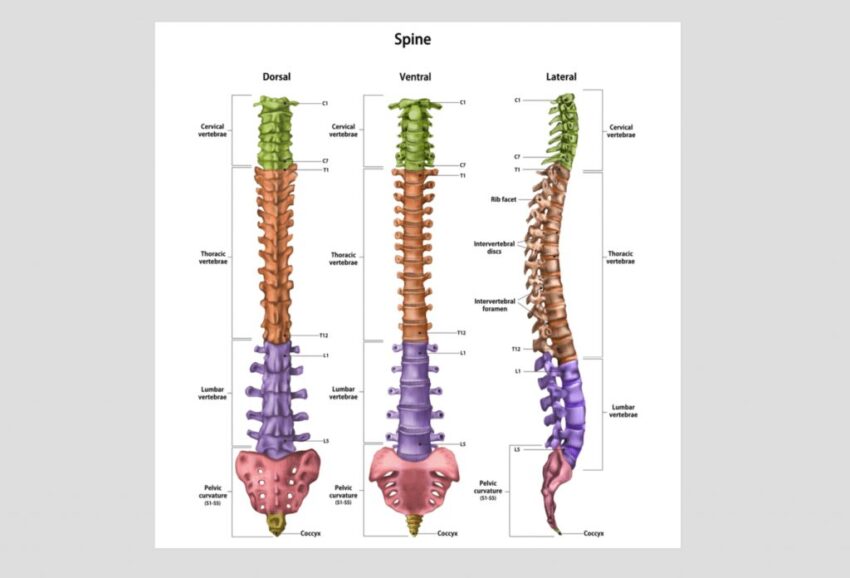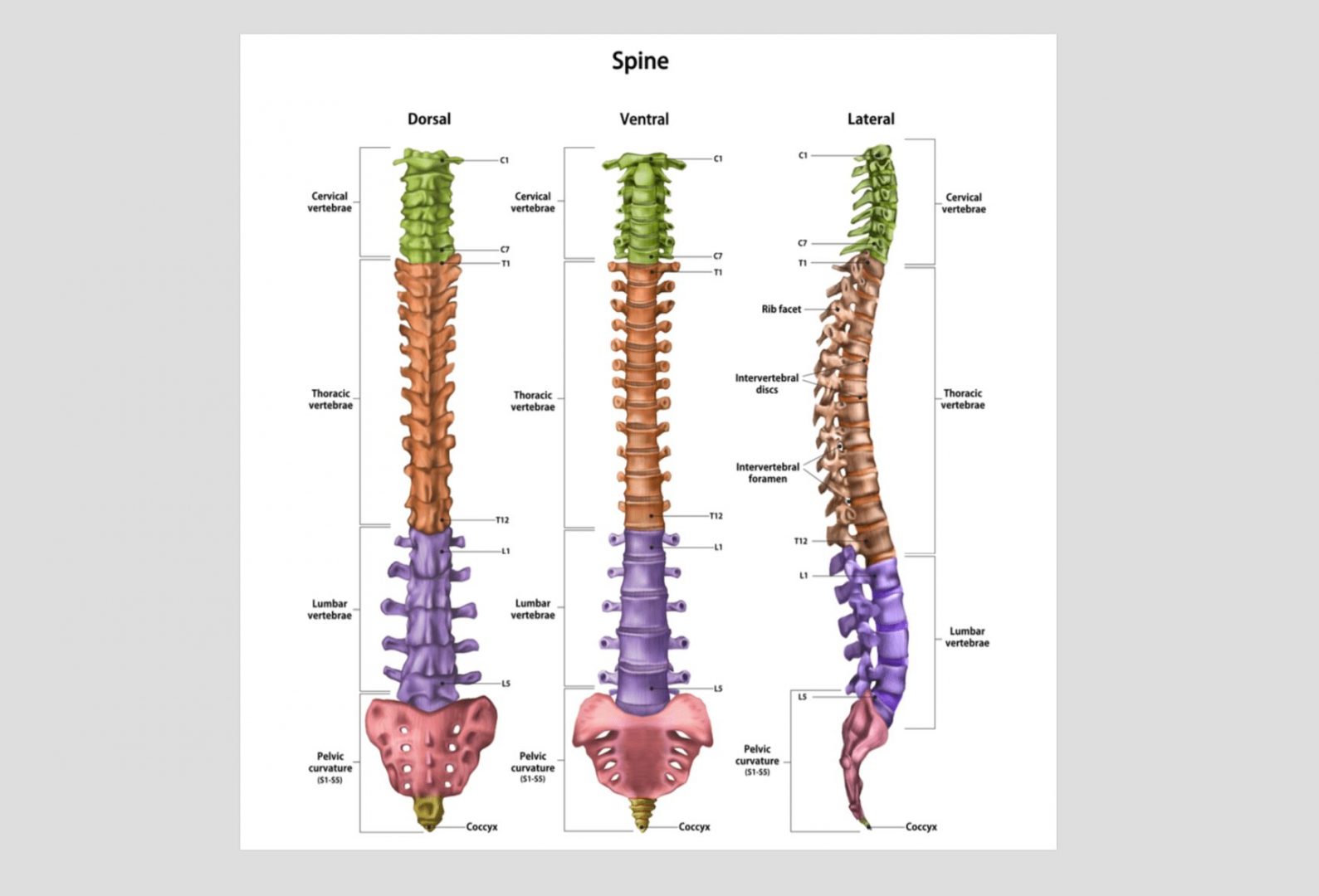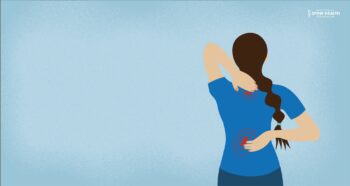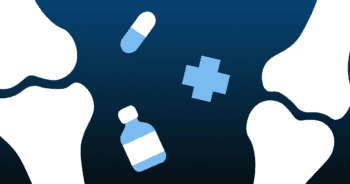The spine is central to the entire human body and is one of the most critical yet often underappreciated and misunderstood body parts we have.
Your spine plays an essential role in supporting the body’s structure and vital functions. It protects the nervous system, facilitates movement, and enables communication between the brain and the rest of the body.
Nevertheless, despite being such a critical structure in the human body, the spine is often misunderstood, which can lead to unnecessary fear and anxiety about spinal health. This misunderstanding can result in the neglect of proper spinal care, exacerbation of existing conditions, and a hesitancy to seek timely medical advice for spine-related issues.
Having a working knowledge of your spinal anatomy and structure is essential because it can help you make informed decisions about which activities and movements are helpful and which may be harmful. This knowledge can help to prevent injury by promoting proper posture, lifting techniques, and exercise practices.
Additionally, an understanding of the anatomy of the spine can help when dealing with occurrences of back and neck pain, and allow you to better communicate with your doctors.
Finally, knowing about your spine’s anatomy and function empowers you to make informed decisions about your healthcare, participate in treatment plans, and take steps to maintain or improve your spinal health.
In this article, we will explain the spine, its anatomy and its different functions by answering some of the following commonly asked questions:
- What does the spine do?
- What are the parts of the spine?
- What are the primary functions of the spine?
- What are the characteristics of a healthy spine?
- What does spine pain have to do with spinal anatomy?
What does the spine do?
The spine is like a strong pillar that keeps us standing tall and allows us to move, sit and bend. Imagine it as a stack of building blocks (the vertebrae) that are connected by strong, flexible bands (ligaments) and cushioned by soft pads (discs). This structure not only helps us stay upright but also supports our body weight and gives us our shape.
But the spine does more than just hold us up. It’s also a highway for information. The nerves of the spinal cord are like a bundle of wires that carry messages between our brain and the rest of our body. When you want to move your arm, for example, your brain sends a signal down the spinal cord to the nerves in your arm, telling it what to do. These nerves also help you feel things – when you touch something hot, the message goes up your spinal cord to your brain, which in turn rapidly tells you to move away before you get burned!
What are the parts of the spine?
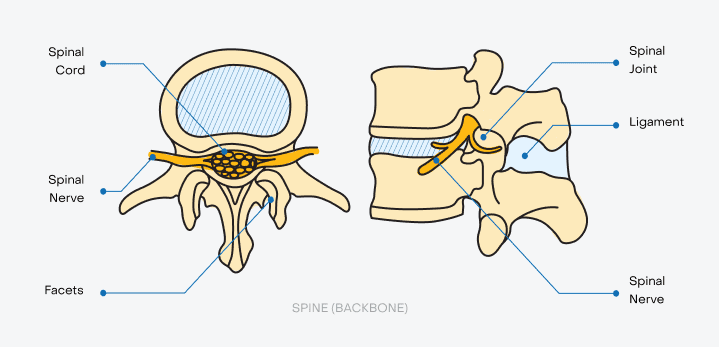
The spine is made up of 6 key elements, each of which contributes to the function and support that it provides. These elements include:
Vertebrae: The bones of the spine. Each vertebra has space in the center, forming a hollow tube when stacked on top of each other so that they protect the spinal canal.
Discs: Soft, cushion-like structures located between adjacent vertebrae. They provide shock absorption, flexibility, and support for the spinal column.
Spinal cord: A long, tubular bundle of nerves that extends from the brainstem down the vertebral column, protected by fluid in the spinal canal and surrounded by ligaments and bone for protection. The spinal cord serves as the central pathway for transmitting sensory and motor signals between the brain and the body through specific nerves.
Facet joints: Small joints that connect the vertebrae and allow for the movement and stability of the spinal column.
Ligaments: Tough, fibrous bands of connective tissue that help stabilize and support the vertebrae.
The entire spinal column consists of 33 individual bones called vertebrae, plus two sections of naturally fused vertebrae – the sacrum and the coccyx – located at the very bottom of the spine. All of these bones and sections are important to the spine’s ability to function properly. Each vertebra has specific anatomical features and functions.

The spine can be divided into five regions:
- Cervical spine (the neck): The first seven vertebrae at the top of the spine.
- Thoracic spine (the back): The twelve vertebrae of the mid-back that are attached to your ribs.
- Lumbar spine (the lower back): The five vertebrae of the lower back.
- Sacrum (the base of the spine): This bone carries all the weight of the body and is the site for many muscles and ligaments to attach to in the hip and pelvic region of the body.
- Coccyx (the tailbone): This tiny triangular-shaped bone consists of four to five fused (joined together) vertebrae.
What is the cervical spine?
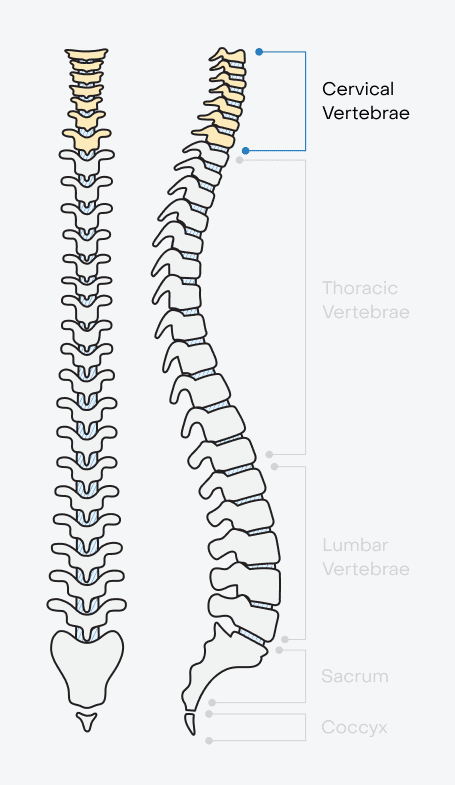
The neck, also called the cervical spine, is a well-engineered structure of bones, nerves, muscles, ligaments, and tendons. The delicate structure of the cervical spine, which houses the spinal cord, is very strong and flexible and allows the neck to move in all directions.
The cervical spine has seven stacked bones called vertebrae, labeled C1 through C7. The first cervical vertebra is called the atlas (C1), and the second is called the axis (C2).
The top of the cervical spine connects to the skull, and the bottom connects to the upper back at about shoulder level. As viewed from the side, the cervical spine curves like an S. This natural curve is anatomically important for managing the weight and pressure from the head.
What is the thoracic spine?
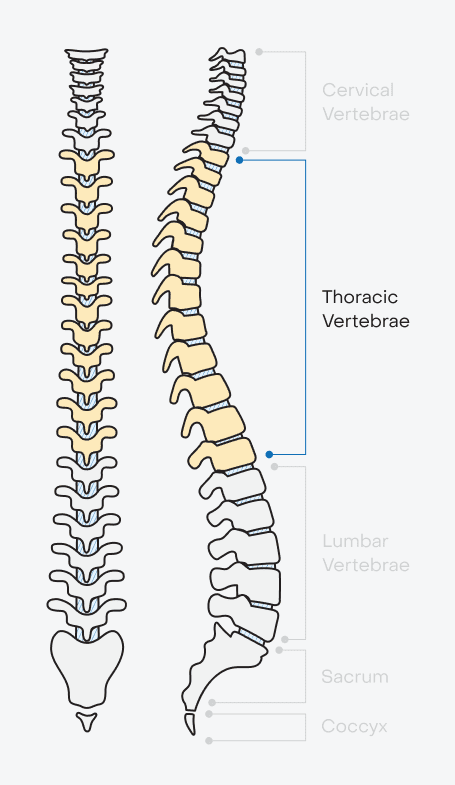
The thoracic spine is the longest region of the spine, and by some measures, it is also the most complex. It creates a connection between the cervical spine and the lumbar spine. It also runs from the base of the neck to the abdomen, making it the only spinal region that attaches to the rib cage.
Some of the thoracic spine’s most important roles include protecting the spinal cord and anchoring the ribs. While the cervical spine and lumbar spine are built more for mobility, the thoracic spine is built more for stability.
What is the lumbar spine?
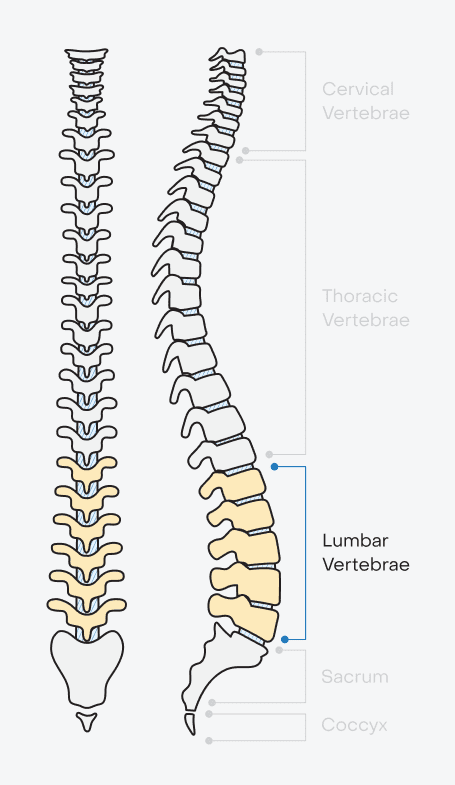
The lumbar spine is the region of the spine in the lower part of the back. The lumbar spine consists of five vertebrae, which support much of the weight of the upper body. These are labeled L1 through L5, with L1 being the uppermost lumbar vertebra and L5 the lowermost. The lumbar vertebrae are physically the largest bones of the entire spine.
The lumbar spine houses nerve roots that exit the spinal cord and form the lumbar plexus. These nerves supply sensation and motor function to the lower extremities, including the legs and feet. The lumbar area is often affected by heavy lifting, sitting for too long, wearing improper shoes, and more. Due to its significant load-bearing role and the stresses placed on the lower back, the lumbar spine is a common site of pain and injury. It is the most common part of the spine to cause disability that prevents people from going to work due to back pain.
What is the sacrum?
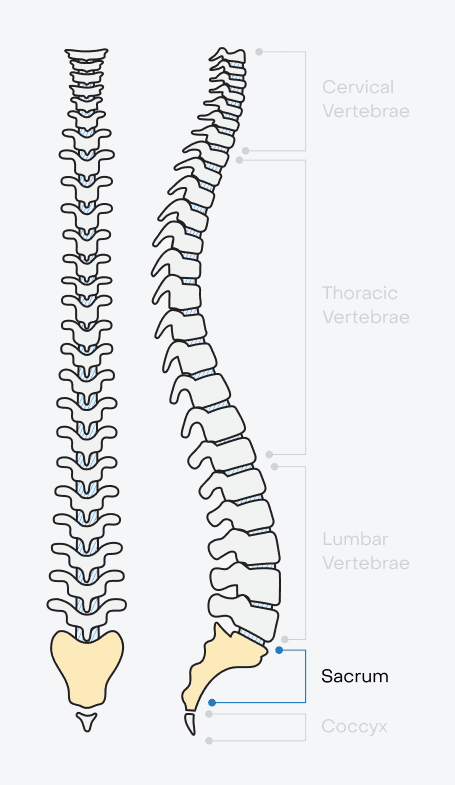
The sacrum is a triangular-shaped bone located at the base of the spine. It is positioned between the lumbar spine (lower back) and the coccyx (tailbone) and serves as a crucial anatomical structure that forms part of the pelvis. The sacrum is formed by the fusion of five individual vertebrae (S1 to S5). These vertebrae fuse together during adolescence to create a single, solid bone.
The sacrum plays an important part in transmitting body weight to the pelvis and protecting the spinal nerves in the lower back. It helps with standing, walking, and other weight-bearing activities.
What is the coccyx?
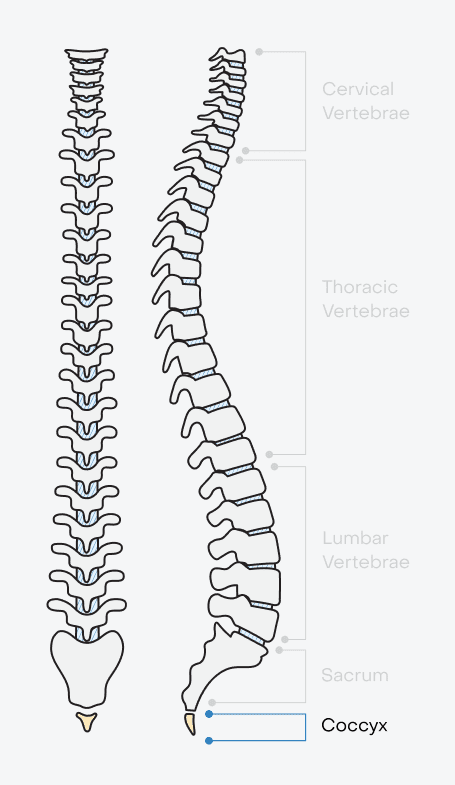
The coccyx, often referred to as the “tailbone,” is a small, triangular bone located at the base of the vertebral column, just below the sacrum.
The coccyx consists of three to five fused or semi-fused vertebrae, although the number can vary among individuals. The coccyx serves as an attachment point for various muscles, tendons, and ligaments in the pelvic region and helps distribute body weight while sitting.
Injuries to the coccyx can occur due to trauma, such as falls or direct blows to the tailbone, leading to pain and discomfort.
What are the primary functions of the spine?
The spine performs numerous functions in the body, but some of the primary functions include:
- Protecting the spinal cord, nerve roots, and internal organs.
- Providing flexibility, motion, and our body’s shape.
- Providing structural support and balance for upright posture.
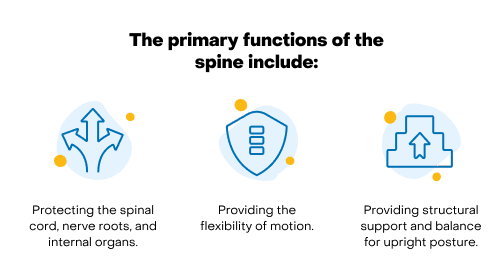
What are the characteristics of a healthy spine?
A healthy spine has strong vertebrae, flexible spinal ligaments, cushiony discs, strong back muscles, and healthy, moveable facet joints. A healthy spine is pain-free.
Strong Bone Density:
Bone density is maintained by a combination of diet and strength training. Multiple studies have shown that people who lift weights and participate in resistance training have overall stronger bones.
Vitamins are also essential to bone health, particularly Vitamin D, which aids in the absorption of calcium.
Flexible Ligaments:
Being physically active, including stretching and strengthening exercises, helps maintain ligament strength. Isometric stretching, meaning holding a stretch for a period of time, is one of the best types of stretching techniques one could utilize. We need to move and have good nutrition to maintain ligament and bone health.
Additionally, a healthy dose of proteins, which are the building blocks for ligaments, needs to be included in your diet.
Cushiony discs:
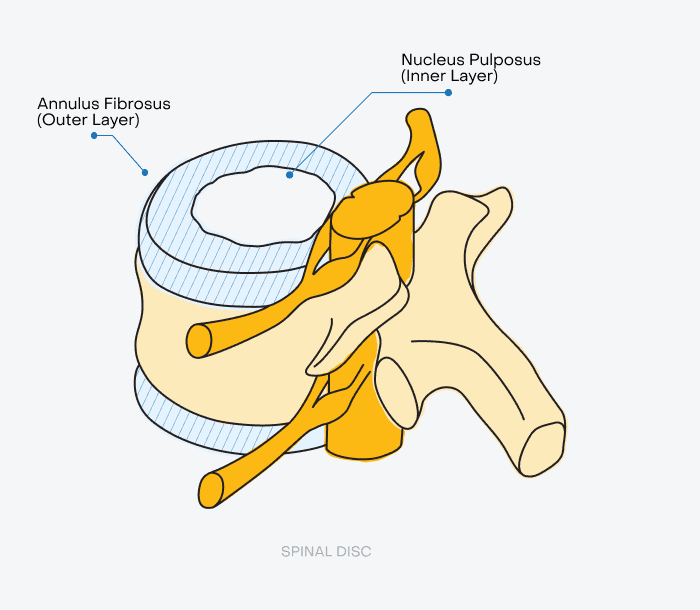
A unique feature of our intervertebral discs is that they do not have a good blood supply . Most of the nutrition comes to the disc through diffusion from the bones above and below them. Activity is important to maintain disc health.
Since discs are made out of collagen, similar to the structures that ligaments are made out of, the same nutritional requirements are needed for discs as for ligaments.
Strong muscles:
Not only are muscles required to lift and move things, but having a strong core of muscles allows our weight to be shared with the spine to take pressure off of the spine.
If your core muscles are strong, then every time you bend, twist or move, those muscles are doing the majority of the work, rather than the spine being overworked.
Smooth facet joints:
Facet joints are small, paired joints located on the back of the vertebral column (spinal column or backbone). When facet joints are smooth and free of arthritis, they can best support the spine. Facet joint pain is a common cause of localized back and neck pain and can also cause referred pain to other areas of the body.
To help protect the facet joints, maintain motion and flexibility, as well as strong muscles and a strong core.
Pain-free:
Individuals with healthy spines do not experience persistent back or neck pain, and they can engage in daily activities without pain hindering their quality of life.
What does spine pain have to do with spine anatomy?
Spine pain is closely related to spine anatomy because spine pain can vary based on the structures and components of the spine that are injured or degenerating.
Any abnormalities or injuries in the spine’s anatomy can significantly impact its function and may lead to various musculoskeletal and neurological problems. A back or spine that is damaged, injured, or arthritic may become painful or stiff. The bones may become weak and have osteoporosis. Today, over 100 million people in the U.S. struggle with chronic spine and back pain.
Injuries:
Traumatic injuries to the spine, such as fractures, dislocations, or ligament sprains, can cause acute and severe pain.
Abnormalities:
Any abnormalities, injuries, or degenerative changes in the components of the spine can lead to pain. Abnormal spinal curvature, for example, such as scoliosis or kyphosis, can lead to muscle imbalances, strain, and pain.
Muscle strain:
The muscles interact with the spine’s structure, so poor posture or muscle strains can lead to muscle-related back pain.
Nerve compression:
The spine houses the spinal cord, which extends down from the brain. Nerve roots branch off from the spinal cord and exit the spinal column through small spaces called intervertebral foramina. If there is compression or irritation of these nerves due to conditions like herniated discs or bone spurs, it can result in localized or radiating pain, such as sciatica.
Gradual aging:
As people age, the components of the spine can naturally degenerate and wear down. Conditions like osteoarthritis, disc degeneration, and spinal stenosis are related to the gradual aging of the spine and can be associated with chronic pain. Maintaining a healthy spine throughout one’s life can prevent chronic pain even as the structures of the spine age.
Conclusion
It’s important to note that the spine’s various components work together to enable movement and support the body. Changes or abnormalities in one part of the spine can affect the entire system.
Spine health directly impacts your quality of life. Overall, the spine’s functions are integral to the body’s stability, movement, and protection of the central nervous system. Understanding the anatomy and function of the spine can help you maintain your spine’s health and reduce the risk of long-term health problems.
